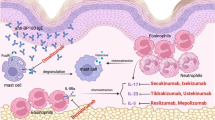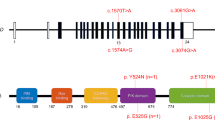Abstract
The objective of this study was to investigate the frequency and functionality of DCs and its associated stimulatory and inhibitory markers in the pathogenesis of PV Active PV patients (n = 30) having both skin and oral lesions, and 30 healthy controls were recruited in the study. The frequency of DCs was determined by flow cytometry followed by the primary culture by using recombinant IL-4 (250 IU/ml) and GM-CSF (600 IU/ml). The culture supernatant was used for ELISA. RNA was isolated from sorted DCs and used for the mRNA expression of DC-associated stimulatory (CD40 and CD80) and inhibitory (PSGL1 and ILT3) markers. Tissue localization of Langerhans cells was done by immunohistochemistry. In this study, altered frequency of myeloid DC (mDC) and plasmacytoid DC (pDC) was seen in the circulation of PV patients. The primary culture of patient-derived DCs showed anomalous cytokine profiling. In the culture supernatant of DCs, elevated levels of TNF-ɑ and IL-12 were detected in PV patients. Meanwhile, reverse trend was found in the case of IFN-ɑ and IL-10 cytokine levels. Similarly, a discrepancy in the expression of DC-associated stimulatory (CD40 and CD80) and inhibitory (PSGL1 and ILT3) markers suggested their possible involvement in the immunopathogenesis of PV. An elevated number of tissue localizing Langerhans cells was also observed in the perilesional skin. This study indicates the distorted frequency and functionality of DCs in the immunopathogenesis of PV. Targeting these functional markers in the future may generate novel therapeutic options for better management of PV.





Similar content being viewed by others
References
Udey MC, Stanley JR. Pemphigus—diseases of antidesmosomal autoimmunity. JAMA. 1999;282:572. https://doi.org/10.1001/jama.282.6.572.
Amagai M, Stanley JR. Desmoglein as a target in skin disease and beyond. J Invest Dermatol. 2012;132:776–84. https://doi.org/10.1038/jid.2011.390.
Bettelli E, Carrier Y, Gao W, Korn T, Strom TB, Oukka M, et al. Reciprocal developmental pathways for the generation of pathogenic effector TH17 and regulatory T cells. Nature. 2006;441:235–8. https://doi.org/10.1038/nature04753.
Asothai R, Anand V, Das D, Antil PS, Khandpur S, Sharma V, et al. Distinctive Treg associated CCR4-CCL22 expression profile with altered frequency of Th17/Treg cell in the immunopathogenesis of pemphigus vulgaris. Immunobiology. 2015;220:1129–35. https://doi.org/10.1016/J.IMBIO.2015.06.008.
Piccioli D, Tavarini S, Borgogni E, Steri V, Nuti S, Sammicheli C, et al. Functional specialization of human circulating CD16 and CD1c myeloid dendritic-cell subsets. Blood. 2007;109:5371–9. https://doi.org/10.1182/blood-2006-08-038422.
Lindstedt M, Lundberg K, Borrebaeck CAK. Gene family clustering identifies functionally associated subsets of human in vivo blood and tonsillar dendritic cells. J Immunol. 2005;175:4839–46. https://doi.org/10.4049/JIMMUNOL.175.8.4839.
Jarrossay D, Napolitani G, Colonna M, Sallusto F, Lanzavecchia A. Specialization and complementarity in microbial molecule recognition by human myeloid and plasmacytoid dendritic cells. Eur J Immunol. 2001;31:3388–93. https://doi.org/10.1002/1521-4141(200111)31:11<3388::AID-IMMU3388>3.0.CO;2-Q.
Charles J, Chaperot L, Salameire D, Di Domizio J, Aspord C, Gressin R, et al. Plasmacytoid dendritic cells and dermatological disorders: focus on their role in autoimmunity and cancer. Eur J Dermatol. 2010;20:16–23. https://doi.org/10.1684/ejd.2010.0816.
Maddur MS, Vani J, Dimitrov JD, Balaji KN, Lacroix-Desmazes S, Kaveri SV, et al. Dendritic cells in. Autoimmune Dis. 2010; https://pdfs.semanticscholar.org/1089/76c522481020558309c535742ed1b70f3adb.pdf (accessed August 30, 2019).
Schreibelt G, Tel J, Sliepen KHEWJ, Benitez-Ribas D, Figdor CG, Adema GJ, et al. Toll-like receptor expression and function in human dendritic cell subsets: implications for dendritic cell-based anti-cancer immunotherapy. Cancer Immunol Immunother. 2010;59:1573–82. https://doi.org/10.1007/s00262-010-0833-1.
Zaba LC, Fuentes-Duculan J, Eungdamrong NJ, Abello MV, Novitskaya I, Pierson KC, et al. psoriasis is characterized by accumulation of immunostimulatory and Th1/Th17 cell-polarizing myeloid dendritic cells. J Invest Dermatol. 2009;129:79–88. https://doi.org/10.1038/jid.2008.194.
Nestle FO, Conrad C, Tun-Kyi A, Homey B, Gombert M, Boyman O, et al. Plasmacytoid predendritic cells initiate psoriasis through interferon-α production. J Exp Med. 2005;202:135–43. https://doi.org/10.1084/jem.20050500.
Sánchez-Madrid Pilar F, Martin MK, Wild D, Vestweber R, Hortensia de la Fuente O, Barreiro IM, et al. Generation of tolerogenic dendritic cells ligand 1/P-selectin interaction in the functional role of P-selectin glycoprotein. J Immunol. 2007;179:7457–65. https://doi.org/10.4049/jimmunol.179.11.7457.
Chang CC, Ciubotariu R, Manavalan JS, Yuan J, Colovai AI, Piazza F, et al. Tolerization of dendritic cells by TS cells: the crucial role of inhibitory receptors ILT3 and ILT4. Nat Immunol. 2002;3:237–43. https://doi.org/10.1038/ni760.
Colonna M, Navarro F, Bellón T, Llano M, García P, Samaridis J, et al. A common inhibitory receptor for major histocompatibility complex class I molecules on human lymphoid and myelomonocytic cells. J Exp Med. 1997;186:1809–18. https://doi.org/10.1084/jem.186.11.1809.
Tseng S-Y, Otsuji M, Gorski K, Huang X, Slansky JE, Pai SI, et al. B7-Dc, a new dendritic cell molecule with potent costimulatory properties for T cells. J Exp Med. 2001;193:839–46. https://doi.org/10.1084/jem.193.7.839.
Latchman Y, Wood CR, Chernova T, Chaudhary D, Borde M, Chernova I, et al. PD-L2 is a second ligand for PD-1 and inhibits T cell activation. Nat Immunol. 2001;2:261–8. https://doi.org/10.1038/85330.
Sancho D, Gómez M, Viedma F, Esplugues E, Gordón-Alonso M, Angeles García-López M, et al. CD69 downregulates autoimmune reactivity through active transforming growth factor-β production in collagen-induced arthritis. J Clin Invest. 2003;112:872–82. https://doi.org/10.1172/JCI19112.
Lamana A, Martin P, de la Fuente H, Martinez-Muñoz L, Cruz-Adalia A, Ramirez-Huesca M, et al. CD69 Modulates sphingosine-1-phosphate-induced migration of skin dendritic cells. J Invest Dermatol. 2011;131:1503–12. https://doi.org/10.1038/jid.2011.54.
Jochems C, Fantini M, Fernando RI, Kwilas AR, Donahue RN, Lepone LM, et al. The IDO1 selective inhibitor epacadostat enhances dendritic cell immunogenicity and lytic ability of tumor antigen-specific T cells. Oncotarget. 2016;7:37762–37,772. https://doi.org/10.18632/oncotarget.9326.
Ludewig B, Odermatt B, Ochsenbein AF, Zinkernagel RM, Hengartner H. Role of dendritic cells in the induction and maintenance of autoimmune diseases. Immunol Rev. 1999;169:45–54 http://www.ncbi.nlm.nih.gov/pubmed/10450507 (accessed August 30, 2019).
Drakesmith H, Chain B, Beverley P. How can dendritic cells cause autoimmune disease? Immunol Today. 2000;21:214–7 http://www.ncbi.nlm.nih.gov/pubmed/10782051 (accessed August 30, 2019).
Turley SJ. Dendritic cells: inciting and inhibiting autoimmunity. Curr Opin Immunol. 2002;14:765–70 http://www.ncbi.nlm.nih.gov/pubmed/12413527 (accessed August 30, 2019).
Marrack P, Kappler J, Kotzin BL. Autoimmune disease: why and where it occurs. Nat Med. 2001;7:899–905. https://doi.org/10.1038/90935.
Bayry J, Thirion M, Delignat S, Misra N, Lacroix-Desmazes S, Kazatchkine MD, et al. Dendritic cells and autoimmunity. Autoimmun Rev. 2004;3:183–7. https://doi.org/10.1016/S1568-9972(03)00104-6.
Ludewig B, Odermatt B, Landmann S, Hengartner H, Zinkernagel RM. Dendritic cells induce autoimmune diabetes and maintain disease via de novo formation of local lymphoid tissue. J Exp Med. 1998;188:1493–501. https://doi.org/10.1084/jem.188.8.1493.
Boyman O, Conrad C, Tonel G, Gilliet M, Nestle FO. The pathogenic role of tissue-resident immune cells in psoriasis. Trends Immunol. 2007;28:51–7. https://doi.org/10.1016/j.it.2006.12.005.
André S, Tough DF, Lacroix-Desmazes S, Kaveri SV, Bayry J. Surveillance of antigen-presenting cells by CD4+ CD25+ regulatory T cells in autoimmunity: immunopathogenesis and therapeutic implications. Am J Pathol. 2009;174:1575–87. https://doi.org/10.2353/ajpath.2009.080987.
Mo J-H, Chung Y-J, Hayashi T, Lee J, Raz E. The role of plasmacytoid and myeloid dendritic cells in induction of asthma in a mouse model and the effect of a TLR9 agonist on dendritic cells. Allergy, Asthma Immunol Res. 2011;3:199. https://doi.org/10.4168/aair.2011.3.3.199.
Chiossi MPV, Costa RS, Roselino AMF. Dermal dendritic cell number correlates with serum autoantibody titers in Brazilian pemphigus foliaceus patients. Braz J Med Biol Res. 2004;37:337–41. https://doi.org/10.1590/S0100-879X2004000300008.
Ganguly D, Haak S, Sisirak V, Reizis B. The role of dendritic cells in autoimmunity. Nat Rev Immunol. 2013;13:566–77. https://doi.org/10.1038/nri3477.
Farkas L, Beiske K, Lund-Johansen F, Brandtzaeg P, Jahnsen FL. Plasmacytoid dendritic cells (natural interferon- alpha/beta-producing cells) accumulate in cutaneous lupus erythematosus lesions. Am J Pathol. 2001;159:237–43. https://doi.org/10.1016/s0002-9440(10)61689-6.
Migita K, Miyashita T, Maeda Y, Kimura H, Nakamura M, Yatsuhashi H, et al. Reduced blood BDCA-2+ (lymphoid) and CD11c+ (myeloid) dendritic cells in systemic lupus erythematosus. Clin Exp Immunol. 2005;142:84–91. https://doi.org/10.1111/j.1365-2249.2005.02897.x.
Joo H, Upchurch K, Zhang W, Ni L, Li D, Xue Y, et al. Opposing roles of dectin-1 expressed on human plasmacytoid dendritic cells and myeloid dendritic cells in Th2 polarization. J Immunol. 2015;195:1723–31. https://doi.org/10.4049/jimmunol.1402276.
Eidsmo L, Martini E. Human Langerhans cells with pro-inflammatory features relocate within psoriasis lesions. Front Immunol. 2018;9:300. https://doi.org/10.3389/fimmu.2018.00300.
Hovav A-H. Mucosal and skin Langerhans cells–nurture calls. Trends Immunol. 2018;39:788–800. https://doi.org/10.1016/j.it.2018.08.007.
Seré K, Baek J-H, Ober-Blöbaum J, Müller-Newen G, Tacke F, Yokota Y, et al. Two distinct types of Langerhans cells populate the skin during steady state and inflammation. Immunity. 2012;37:905–16. https://doi.org/10.1016/j.immuni.2012.07.019.
Hengartner H, Odermat B, Schneider R, Schreyer M, Wälle G, MacDonald HR, et al. Deletion of self-reactive T cells before entry into the thymus medulla. Nature. 1988;336:388–90. https://doi.org/10.1038/336388a0.
Watanabe N, Wang Y-H, Lee HK, Ito T, Wang Y-H, Cao W, et al. Hassall’s corpuscles instruct dendritic cells to induce CD4+CD25+ regulatory T cells in human thymus. Nature. 2005;436:1181–5. https://doi.org/10.1038/nature03886.
Ochando JC, Homma C, Yang Y, Hidalgo A, Garin A, Tacke F, et al. Alloantigen-presenting plasmacytoid dendritic cells mediate tolerance to vascularized grafts. Nat Immunol. 2006;7:652–62. https://doi.org/10.1038/ni1333.
Ito T, Yang M, Wang Y-H, Lande R, Gregorio J, Perng OA, et al. Plasmacytoid dendritic cells prime IL-10–producing T regulatory cells by inducible costimulator ligand. J Exp Med. 2007;204:105–15. https://doi.org/10.1084/jem.20061660.
Gilliet M, Liu Y-J. Generation of human CD8 T regulatory cells by CD40 ligand–activated plasmacytoid dendritic cells. J Exp Med. 2002;195:695–704. https://doi.org/10.1084/jem.20011603.
Urzainqui A, Martinez G, Hoyo D, Barreiro O, Martin P. Functional role of P-selectin glycoprotein ligand 1/P-selectin interaction in the generation of tolerogenic dendritic cells A Novel Cervical Spinal Cord Window Preparation Allows for Two-Photon Imaging of T Cell Interactions with the Cervical Spinal Cord Microvasculature during Experimental Autoimmune Encephalomyelitis View project Ultrasound molecular imaging View project, Artic. J Immunol. 2008. https://doi.org/10.4049/jimmunol.179.11.7457.
Nickoloff BJ, Nestle FO. Recent insights into the immunopathogenesis of psoriasis provide new therapeutic opportunities. J Clin Invest. 2004;113:1664–75. https://doi.org/10.1172/JCI22147.
Acknowledgments
We thank All India Institute of Medical Sciences, New Delhi, India, for providing the Intramural Research Grant (IRG) to carry out this work.
Funding
This study received funding from the Indian Council of Medical Research (ICMR- 61/4/2018-BMS) (Project code I-1034).
Author information
Authors and Affiliations
Corresponding author
Ethics declarations
The Institutional Ethical clearance was obtained before initiating the study. The informed consent from all the study subjects was taken.
Conflict of interest
The authors declare that they have no conflict of interest.
Additional information
Publisher’s note
Springer Nature remains neutral with regard to jurisdictional claims in published maps and institutional affiliations.
Supplementary information
ESM 1
(DOCX 653 kb)
Rights and permissions
About this article
Cite this article
Das, D., Singh, A., Antil, P.S. et al. Distorted frequency of dendritic cells and their associated stimulatory and inhibitory markers augment the pathogenesis of pemphigus vulgaris. Immunol Res 68, 353–362 (2020). https://doi.org/10.1007/s12026-020-09166-0
Received:
Accepted:
Published:
Issue Date:
DOI: https://doi.org/10.1007/s12026-020-09166-0




